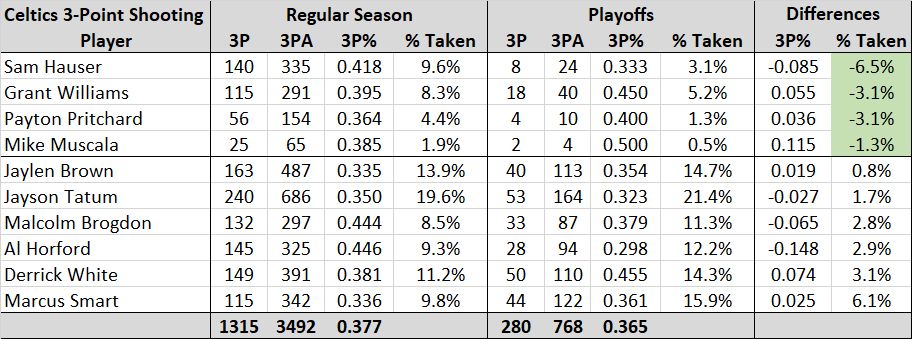The Forgotten Four

There has been a lot of talk about how the Celtics chose to live and die by the three in the playoffs. This isn't entirely fair, and only seems that way in relation to their two final opponents. The Celtics shot 38.7 threes per game in the playoffs this year, which ranked fourth-highest behind Golden State, Milwaukee, and Sacramento. It seems like they only took threes because their final two opponents shots – Philadelphia (33.9, eighth-most) and Miami (33.6, 10th-most) shot roughly five fewer threes per game. The league average for the playoffs thus far has been 34.6, to give you a little context. So, the C's were above average, but far south of No. 1 Golden State, which clocked in at 42.5.
I would submit that the problem was not how many threes, but rather who was shooting them. Let's take a look:

In the regular season, the Celtics shot .377 from three-point territory, a percentage that ranked sixth-best in the NBA, and 16 points above the league average of .361. But in the playoffs, that percentage dropped to .365, just 13 points ahead of the league average of .353. If you look at just the eight teams that advanced to the conference semifinal round, that league average ticks up to .356. In other words, the C's three-point shooting fell back to the pack in a big way in the postseason.
There are two big reasons for this srop off. One, you can see highlighted in green in the right-most column in the chart above. Many of the players who shot the three ball the best in the regular season shot far fewer of the team's threes in the postseason than in the regular season. While you perhaps wouldn't expect to see Mike Muscala in uniform as much in the postseason, certainly you did with the other three. Taken together, I'm going to think of them as "The Forgotten Four." Let's simplify the chart above to split out these four versus what we'll call "The Core Six":

In the playoffs, these four players shot the three better than in the regular season, but they took 14% fewer threes than they did in the regular season. Meanwhile, the Core Six players took 17.4% more of the team's threes, and shot 14 points worse while taking them.
At one point in the season, coach Joe Mazzulla made a flippant remark about how taking a lot of threes was just math, and that he liked math. Unfortunately, you also have to tailor your personnel to your strategy, and trust your bench. By failing to trust Sam Hauser, Payton Pritchard, and Grant Williams more, he put his team in a position where the math no longer made sense.
On the other side of the court in the Conference Finals, we saw the Miami Heat entrust significant playoff minutes to their 10th and 11th men – that's where Haywood Highsmith and Duncan Robinson ranked in terms of minutes played per game for Miami in the regular season. Yes, Miami coach Erik Spoelstra ended up benching Kevin Love and Cody Zeller as the series progressed, but it wasn't to tighten his rotation, but rather augment it – the Heat chose to play small, and it worked. They trusted their guys.
When Mazzulla cut The Forgotten Four from the rotation, he not only proved he couldn't/wouldn't trust his guys, he also changed the math. This was exacerbated by the fact that Al Horford and Malcolm Brogdon were significantly worse shooters in the postseason, and that Jayson Tatum was also worse. This dragged down the group as a whole, even though Jaylen Brown, Marcus Smart, and Derrick White were better overall (though Jaylen's numbers fell off a cliff in the Conference Finals).
Looking just at Brogdon and Horford, the difference is so alarming I can't believe nothing was ever done to remedy the situation. In the regular season, the duo hit 277 of their 622 threes, for a sterling .445 3-point percentage. For his career, Ray Allen shot .400 from deep. That .445 is an incredible percentage. Any time you can say you were that much better than Ray Allen, you have something.
But in the playoffs, the duo combined to hit just 61 of 181 threes, for a below-average .337 – a difference of 108 points. That is a ghastly dropoff, and while you would expect some drop off, that is an untenable drop. It was even worse in the Conference Finals, as the pair hit just 11 of 47 threes, for a .234 mark. Honestly, that makes me want to cry.
Mazzulla eventually saw fit to give Grant Williams more run in the Conference Finals, but more than anything it seemed like he caved to media and fan pressure more than it was a deliberate strategy, but Grant at least earned his minutes – he hit nine of his 21 threes in the Conference Finals, good for a .429 mark. But that Mazzulla didn't recognize that the guys taking the threes weren't falling and didn't give more minutes to Sam Hauser – even if it was just in Game 7 – is frankly pretty alarming.
The Celtics did not necessarily live and die by the three, but they certainly lived and died by who they chose to let take those threes. What makes it hurt all the more is that many of us had the same critique during last year's NBA Finals. Eventually, the C's will have to decide to either fully trust Hauser and Pritchard, or trade them for players they can trust.
